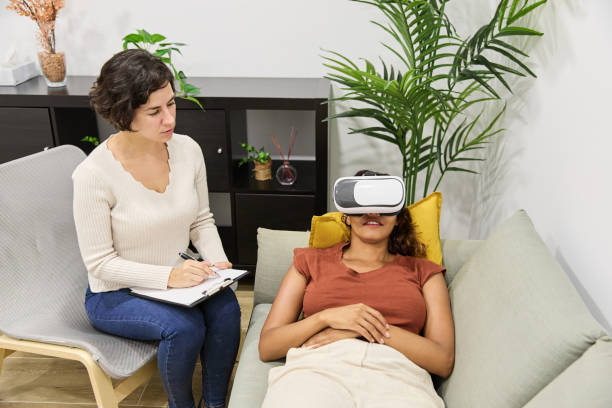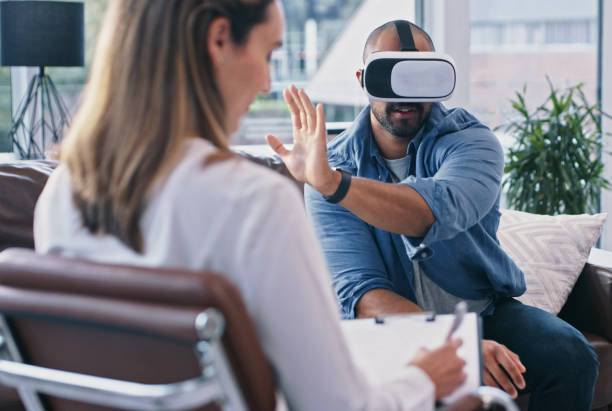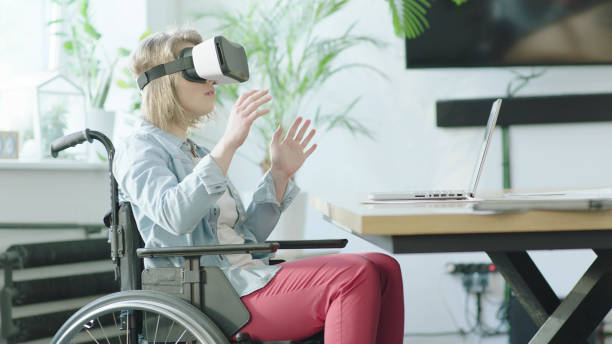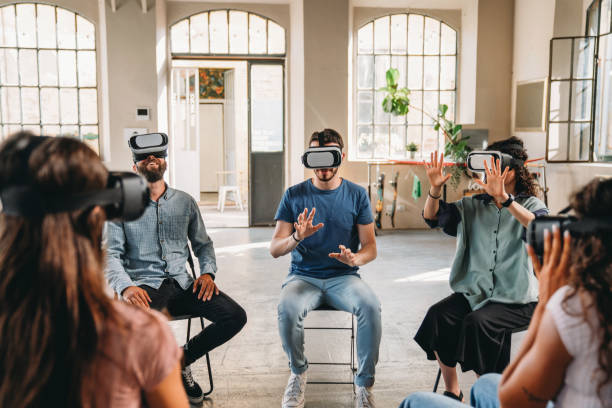Virtual Reality Therapy: Stepping into a World of Healing
 Imagine conquering your fear of heights by scaling a virtual mountain peak, or confronting your social anxiety by giving a speech in a safe, simulated environment. This isn't science fiction; it's the transformative power of virtual reality (VR) therapy. VR is revolutionizing the mental health landscape, offering innovative and immersive experiences that are proving remarkably effective in treating a wide range of conditions.
Imagine conquering your fear of heights by scaling a virtual mountain peak, or confronting your social anxiety by giving a speech in a safe, simulated environment. This isn't science fiction; it's the transformative power of virtual reality (VR) therapy. VR is revolutionizing the mental health landscape, offering innovative and immersive experiences that are proving remarkably effective in treating a wide range of conditions.
From Pixels to Progress: How VR Therapy Works
 VR therapy utilizes cutting-edge technology to create realistic and interactive virtual environments. Using a VR headset and sometimes additional controllers, users are transported to simulated worlds designed to address their specific phobias, anxieties, or traumas.
VR therapy utilizes cutting-edge technology to create realistic and interactive virtual environments. Using a VR headset and sometimes additional controllers, users are transported to simulated worlds designed to address their specific phobias, anxieties, or traumas.
Here's a glimpse into the VR therapy experience:
- Exposure Therapy Reimagined: Traditional exposure therapy involves gradually exposing patients to their phobias in a controlled setting. VR allows for a much more immersive and controlled exposure. For example, someone with a fear of flying can virtually experience a plane journey, complete with sights, sounds, and even turbulence – all from the comfort of a therapist's office.
- Safe Exploration: VR environments offer a safe space to confront fears and practice coping mechanisms. Patients can experiment with different approaches in a virtual world without the real-world consequences. This allows for faster progress and increased confidence.
- Tailored Experiences: The beauty of VR therapy lies in its customizability. Therapists can design virtual scenarios that directly target a patient's specific triggers, ensuring a highly personalized treatment experience.
Beyond Exposure Therapy: A Spectrum of Applications
VR therapy isn't limited to treating phobias. Here are some of the exciting applications in the mental health field:
- Post-Traumatic Stress Disorder (PTSD): VR can help veterans and others with PTSD relive traumatic experiences in a safe environment, allowing them to process and overcome the emotional impact.
- Anxiety Disorders: Social anxiety, generalized anxiety, and panic attacks can all be effectively addressed through VR therapy. Patients can gradually confront their triggers in a virtual world, building confidence and resilience.
- Pain Management: VR can be a powerful tool for distraction and pain management. Immersive experiences can help patients focus on something other than their pain, reducing its perceived intensity.
- Autism Spectrum Disorder (ASD): VR can provide a safe space for individuals with ASD to practice social interactions and communication skills in a controlled environment.
- Substance Abuse Treatment: VR can be used to create simulations that trigger cravings in a safe setting, allowing patients to practice coping mechanisms and relapse prevention strategies.
The Science Behind the Therapy: Why VR Works
The effectiveness of VR therapy stems from its ability to harness the power of the human brain. Here's what science tells us:
- Immersion is Key: VR creates a sense of presence, tricking the brain into believing the virtual environment is real. This powerful immersion allows for a more impactful emotional response compared to traditional therapy methods.
- Neuroplasticity in Action: Our brains are remarkably adaptable. VR therapy can stimulate neuroplasticity, the brain's ability to form new neural pathways. By repeatedly confronting fears and practicing coping mechanisms in a safe, virtual environment, patients can rewire their brains for a more positive response.
- Emotional Engagement: VR experiences can evoke strong emotional responses, which can be a catalyst for therapeutic progress. Processing these emotions in a safe space with a therapist's guidance can lead to significant healing.
Beyond the Hype: Is VR Therapy Right for You?
While VR therapy holds immense promise, it's important to consider its limitations:
- Accessibility: VR equipment can be expensive, and access to qualified VR therapists might be limited in certain areas.
- Technical Challenges: Not everyone feels comfortable wearing a VR headset, and some may experience motion sickness.
- Not a Standalone Solution: VR therapy is most effective when used in conjunction with traditional therapy methods like cognitive behavioral therapy (CBT).
A Glimpse into the Future: The VR Therapy Landscape Expands
The future of VR therapy is brimming with possibilities. Here are some exciting trends to watch:
- VR combined with Biofeedback: Integrating biofeedback sensors into VR experiences can provide therapists with real-time data on a patient's physiological responses during virtual exposure, allowing for more personalized treatment plans.
- Group VR Therapy: Imagine a virtual support group where individuals with similar challenges can interact and learn from each other in a safe, immersive environment.
- VR for Mental Health Screening: VR experiences could potentially be used as screening tools for mental health conditions, allowing for early intervention and treatment.
Stepping into a Brighter Future
VR therapy represents a revolutionary shift in the mental health landscape. By harnessing the power of immersive experiences, it's offering a path to healing for millions struggling with anxiety, phobias, and other conditions. While VR therapy represents a revolutionary shift in the mental health landscape. By harnessing the power of immersive experiences, it's offering a path to healing for millions struggling with anxiety, phobias, and other conditions. While VR technology is still evolving, its potential to transform mental healthcare is undeniable.
Taking the First Step: Exploring VR Therapy Options
 If you're curious about VR therapy, here are some steps you can take:
If you're curious about VR therapy, here are some steps you can take:
- Talk to Your Therapist: Discuss your interest in VR therapy with your current therapist. They can assess if you're a good candidate and guide you towards qualified VR therapy providers.
- Research VR Therapy Centers: Look for mental health institutions or private practices that offer VR therapy services. Many advertise their services online.
- Embrace the Journey: VR therapy can be a transformative experience. Approach it with an open mind and a willingness to participate actively in your treatment plan.
The future of mental health is no longer confined to a therapist's office. With virtual reality therapy, healing can take place in a world of limitless possibilities. Are you ready to step into a world of healing?










































